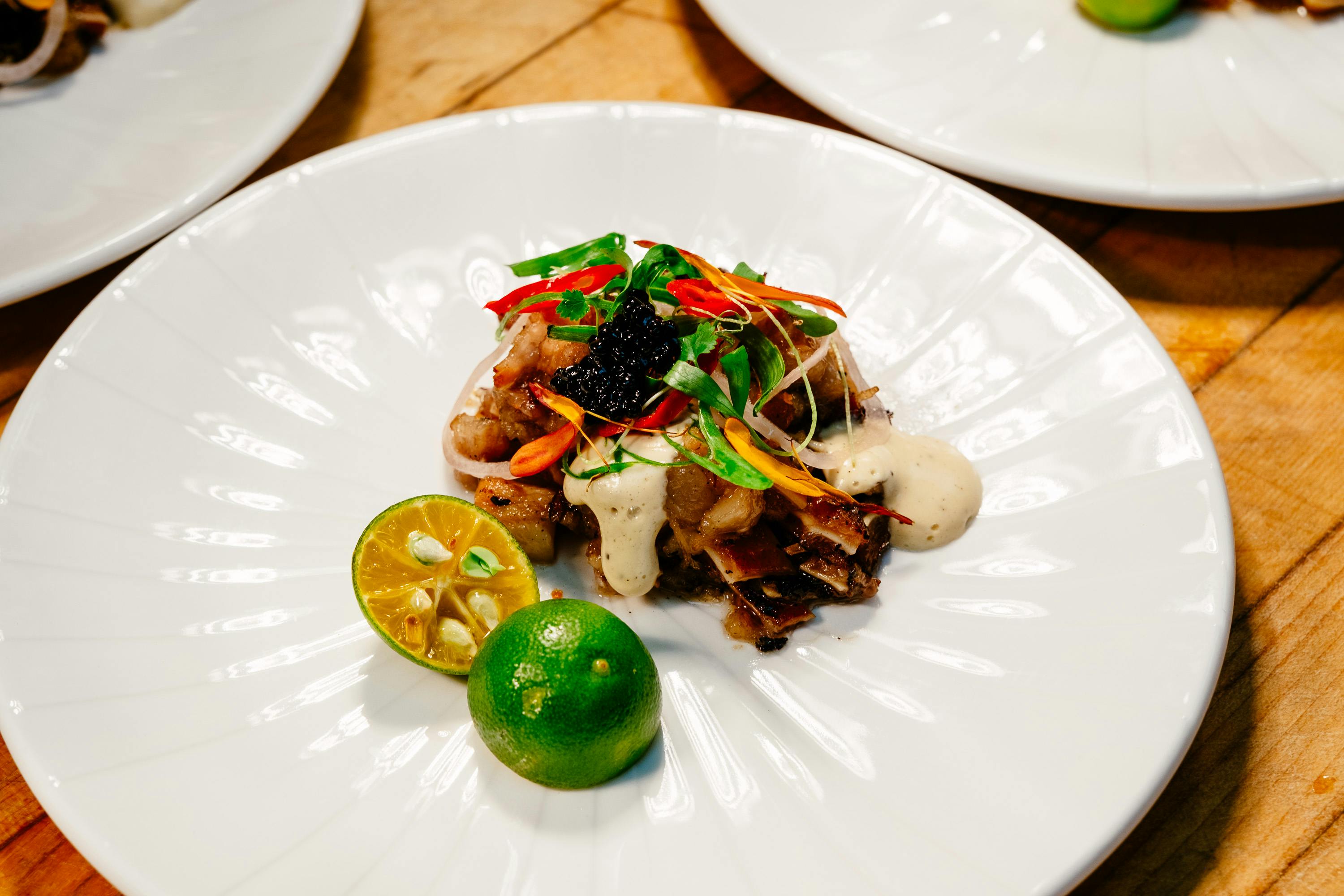Posted by on 18 Jul 2025
The Philippines is a gastronomic paradise waiting to be explored, where each island offers its own unique culinary identity shaped by centuries of tradition, cultural influences and abundant local ingredients. From the smoky aromas of Cebu's legendary lechon to the ocean-fresh seafood of Palawan and the tangy, mouth-puckering delights of Ilocos, Filipino cuisine tells the story of the 7,641 islands through unforgettable flavours and time-honoured cooking traditions.
For travellers seeking authentic cultural experiences, the Philippines presents an extraordinary opportunity to embark on a culinary adventure that goes far beyond typical tourist fare. This archipelago nation has perfected the art of transforming simple, local ingredients into complex, flavourful dishes that reflect the warmth and hospitality of Filipino culture.
Cebu: The Lechon Capital of the Philippines
No culinary journey through the Philippines would be complete without experiencing Cebu's crown jewel – the world-renowned lechon. This isn't just any roasted pig; Cebu's lechon represents the pinnacle of Filipino culinary artistry, where whole pigs are slowly roasted over charcoal for hours until the skin achieves that perfect golden crisp. At the same time, the meat remains impossibly tender and flavourful.
What sets Cebu's lechon apart from that of other regions is its unique preparation method. Local lechoneros (roasters) stuff the pig's cavity with native herbs, including lemongrass, bay leaves and onions, creating an aromatic infusion that permeates every bite. The result is a dish so celebrated that even renowned chef Anthony Bourdain declared it "the best pig ever."
Beyond lechon, Cebu's culinary landscape offers fascinating discoveries for food enthusiasts:
Ngohiong - Spring rolls filled with vegetables and meat, reflecting the city's Chinese heritage
Puso - Hanging rice cooked in woven coconut leaves, a unique local staple
Sutukil - An interactive dining concept where you select fresh seafood prepared three ways:
Sugba (grilled)
Tuwa (soup)
Kilaw (ceviche-style)
Bohol: Heritage and Home-Style Flavours
Just a short ferry ride from Cebu, Bohol offers more than its iconic Chocolate Hills. It’s also home to a culinary scene deeply rooted in tradition and local pride. Here, food reflects the rhythm of island life, often made with humble ingredients transformed into comforting, flavourful dishes passed down through generations.
What sets Boholano cuisine apart is its honest simplicity and use of locally grown produce and freshly caught seafood. Whether you’re sipping warm binignit during a rainy afternoon or scooping sticky calamay straight from a coconut shell, every bite feels like home.
Beyond its natural wonders, Bohol’s culinary landscape offers tasty local discoveries for curious food lovers:
Calamay – A sticky rice delicacy made with glutinous rice, coconut milk, and brown sugar, traditionally cooked in vats and sold in coconut shells sealed with red cellophane
Binignit – A warm dessert soup made with root vegetables, banana and sago simmered in sweet coconut milk
Sea Urchin (Tuyom) – A coastal delicacy typically eaten raw or with a splash of vinegar and chilli
When planning your Cebu and Bohol adventure, consider timing your visit to coincide with local food festivals or arrange visits to traditional lechon establishments, where you can witness the entire roasting process and learn about the cultural significance of this beloved dish.
Palawan: Ocean-to-Table Paradise
Palawan's culinary identity is deeply rooted in its pristine waters and abundant marine life. This island province offers some of the Philippines' freshest and most diverse seafood experiences, where the catch of the day often determines the evening's menu.
The seafood markets of Puerto Princesa and El Nido present a spectacular array of tropical marine life:
Giant prawns and mud crabs fresh from coastal waters
Premium fish, including fresh tuna, red snapper and the prized lapu-lapu (grouper)
Exotic varieties that many Western visitors encounter for the first time
These are prepared using traditional methods that highlight their natural flavours rather than masking them.
Palawan's signature dishes showcase this ocean bounty:
Kinilaw - Filipino ceviche where ultra-fresh fish is "cooked" in coconut vinegar and calamansi juice, mixed with onions, ginger and chilli
Tamilok - Woodworm delicacy served fresh with vinegar and spices (for the truly adventurous)
Inihaw specialties - Fresh fish wrapped in banana leaves and grilled over coconut husks
The cooking methods in Palawan often reflect the island's laid-back atmosphere. Inihaw (grilling) is particularly popular, with fresh fish wrapped in banana leaves and cooked over coconut husks, imparting a subtle smoky flavour that enhances rather than overpowers the seafood's natural taste.
Your Puerto Princesa and El Nido experience can include market tours with local chefs. These boat trips combine island hopping with fresh seafood lunches and beachside dining experiences where your meal is prepared right on the sand.
Ilocos: Masters of Sour and Savoury
The Ilocos region in northern Luzon has developed a distinctive culinary identity characterised by bold, sour flavours and ingenious preservation techniques. The region's signature dishes reflect the resourcefulness of its people:
Pinakbet - Vegetable stew combining bitter melon, eggplant, okra and tomatoes with bagoong (fermented shrimp paste), balancing bitter, salty and umami elements
Longganisa - Distinctive garlicky sausage, smaller and more flavourful than Spanish chorizo, typically served with garlic rice and fried eggs.
Bagnet - Twice-cooked pork belly that's deep-fried to achieve maximum crispiness whilst maintaining incredibly juicy meat underneath
Sinigang variations - Sour soups using native souring agents like kamias (bilimbi), tamarind and green mangoes
Palawan: From Market to Shore in Puerto Princesa and El Nido
Palawan’s culinary strength lies in its access to the freshest seafood imaginable. In Puerto Princesa and El Nido, daily catches from the sea are transformed into simple yet flavour-packed dishes that showcase the island’s laid-back lifestyle and deep connection to nature. The focus here is on freshness, balance, and letting the ingredients shine.
Must-try local fare includes:
Kinilaw – Filipino-style ceviche made with raw fish marinated in coconut vinegar, calamansi, and chilli
Inihaw na Isda – Whole fish, often lapu-lapu or bangus, seasoned and grilled over open coals, then served with a dipping sauce of soy, vinegar, and crushed chillies
Chao Long Noodles – A Vietnamese-Filipino fusion noodle soup with beef or pork, introduced by settlers after the war
Visitors can enjoy open-air seafood markets, beachfront barbecues, or take part in island-hopping tours that include meals freshly prepared on the sand.
Siargao and Siquijor: Island Vibes and Plant-Based Fare
Known for their laid-back energy, surf culture, and crystal-clear waters, Siargao and Siquijor are also carving out their place on the Philippines’ culinary map. These islands invite travellers to slow down, savour the flavours of the tropics, and explore a mix of wholesome modern fare and rustic island favourites.
Siargao has emerged as a hotspot for wellness-inspired cuisine, with a growing number of cafés serving plant-based meals, smoothie bowls, vegan curries and poke made with freshly caught fish. Amid the trendy health food scene, traditional flavours remain just as accessible.
Must-try local dishes include:
Paksiw na Isda – A staple among islanders, this dish features fresh fish simmered in vinegar, garlic, and ginger
Lato (Sea Grapes) – Often served as a salad with chopped tomatoes and calamansi
Pan de Coco – A soft, sweet bread filled with grated coconut and brown sugar
In Siquijor, food takes a rustic turn. Known for its mystical charm and tranquil beaches, the island also offers hearty fare cooked over wood fire. Local highlights include grilled native chicken, cassava-based desserts, and coconut-infused dishes made the old-fashioned way. You’ll find humble eateries and seaside stalls that let the simplicity of island ingredients shine.
Dumaguete: Gateway to Flavours of Negros Oriental
Dumaguete, often called the “City of Gentle People,” is more than just a jumping-off point to Apo Island or neighbouring Siquijor. It’s a university town with a cosmopolitan vibe and a food scene that reflects a blend of Spanish colonial heritage and Visayan culinary traditions.
Here, comfort food takes centre stage, from morning sticky rice snacks to indulgent pastries that pair beautifully with locally grown coffee.
Must-try Dumaguete favourites:
Budbud Kabog – A traditional delicacy made from millet and wrapped in banana leaves
Sans Rival – The city’s signature dessert made of layered meringue, cashew, and buttercream
Silvanas – Frozen cookie sandwiches made of cashew meringue and buttercream, dusted in cookie crumbs
Don’t miss a market tour or a coastal seafood lunch featuring grilled squid and kinilaw.
The Coron Islands and Boracay: Seafood and Sunset Dining
The Coron Islands offer a raw, back-to-basics island dining experience that focuses on what the sea has to offer. In this remote part of Palawan, meals are simple, fresh, and unforgettable, often served beachside after a day of snorkelling or island hopping.
Expect no-fuss, high-flavour dishes like:
Grilled Lobster – Cooked over charcoal and served with garlic butter or calamansi for dipping
Clam Soup (Imbao) – A clear broth made with native clams, lemongrass, and ginger
Tuna Belly Inihaw – Marinated and grilled to perfection, offering smoky richness
Manila: Where Culinary Traditions Meet Cosmopolitan Cool
Manila is where all of the Philippines' regional flavours converge. As the country’s bustling capital, it offers a dynamic food scene that ranges from humble street food stalls to world-class restaurants, making it the ideal starting (or ending) point for any Filipino culinary adventure.
Must-eats that reflect Manila’s cultural and culinary diversity include:
Adobo – Each household has its own version of this soy-vinegar braised dish
Halo-Halo – A kaleidoscope of ingredients layered over crushed ice, evaporated milk, and leche flanKare-Kare – A slow-cooked peanut stew with oxtail and vegetables, often served with fermented shrimp paste (bagoong)
To dive deeper, join a Binondo food crawl through the world’s oldest Chinatown, explore hip cafés in Poblacion, or learn to cook regional dishes in a hands-on class with a Manila-based chef.
Traditional Cooking Methods and Cultural Heritage
Filipino cooking methods have remained largely unchanged for generations, representing living links to pre-colonial traditions:
Palayok cooking - Clay pots that impart subtle earthy flavours and distribute heat evenly
Banana leaf techniques - Natural plates, food wrappers and flavour enhancers that add herbal notes whilst keeping food moist
Kamayan dining - The cultural practice of eating with hands, emphasising community, sharing and connection to food
These traditional methods appear across multiple cooking applications:
Rice dishes wrapped in banana leaves for enhanced flavour
Fish preparations that absorb natural leaf aromatics
Native delicacies that showcase ancestral cooking wisdom
Food Tours and Hands-On Cooking Experiences
The best way to truly understand Filipino cuisine is through immersive experiences that combine tasting, learning and cultural exchange:
Food Tours with Local Guides:
Insider access to hidden gems and family-run establishments
Authentic preparation techniques that independent travellers might miss
Cultural context and stories behind traditional dishes
Hands-On Cooking Classes:
Market tours to select fresh ingredients and learn about native produce
Home-based experiences provide intimate glimpses into Filipino family life
Essential skills like making perfect rice, balancing adobo flavours and rolling lumpia
Street Food Adventures:
Crispy pork sisig served on sizzling plates
Sweet halo-halo (shaved ice dessert) for tropical heat relief
True Filipino comfort food accessible to everyone
Planning Your Filipino Food Adventure
The Philippines' culinary diversity means that every region offers unique flavours and experiences worth exploring:
Regional Highlights:
Cebu - Smoky lechon and Chinese-influenced specialties
Palawan - Ocean-fresh seafood and traditional grilling methods
Ilocos - Bold sour flavours and ingenious preservation techniques
Keys to Culinary Success:
Maintain an open mind and adventurous spirit
Allow time to explore flavours that might initially seem unfamiliar
Engage with local food culture on multiple levels through various experiences
Food in the Philippines represents celebration, community and cultural expression in every meal, from elaborate feast preparations for special occasions to simple street food shared among friends.
Ready to embark on your own Filipino culinary adventure? Contact our expert travel consultants to design a personalised food-focused itinerary that combines the best flavours of the Philippines with unforgettable cultural experiences and insider access to authentic local cuisine.


